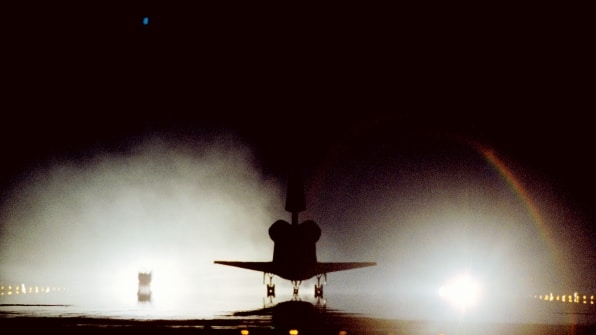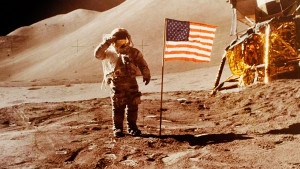Forget Starfleet Academy—Future Astronauts Will Be Trained By These Companies
Private space travel could be just a year away.
Jeff Bezos’s Blue Origin recently released images of the spaceships it says could be ferrying paying guests to suborbital space in 2018. At the same time, Richard Branson’s Virgin Galactic has hundreds of $250,000 deposits from people who want seats on his spacecraft, and SpaceX’s Elon Musk aims to take a pair of tourists around the moon.
As commercial spaceflights for tourists, scientists, and workers in the burgeoning space economy become more common, experts say those would-be astronauts will need training that goes well beyond earthbound airline safety briefings. Anyone venturing into space will need to know how to deal with space sickness, the effects of acceleration and weightlessness, and even the potential for hallucinations. And those going to do scientific or other work will have to be ready to use their limited time optimally—time outside the earth’s gravitational pull will cost something like $688 per second, according to Gregory Kennedy, education director at the NASTAR Center.
“The research organizations that are sponsoring their flights are going to want to make sure they’re getting their $688,” he says.
The NASTAR Center, located outside Philadelphia, is one of several commercial institutions offering spaceflight training for would-be private astronauts. Founded in 2007 by the Environmental Tectonics Corporation, which makes air and space training equipment, the center has trained more than 500 people for the rigors of spaceflight, Kennedy says. For aspiring space tourists, that includes learning how to tolerate the acceleration forces they’ll experience: “We take somebody with no prior experience and build them up to be able to withstand up to 6 Gs.”
For scientists, the training entails time management and team coordination drills. “We do an exercise where we have them do some activities that may conflict with each other or may distract each other,” says Kennedy, usually with participants failing to finish on time. “Then, we just give them a chance to do a simple mission rehearsal [and] planning. We have them do it again, and everybody finishes.”
Space And The Human Body
Outside Boston, SIRIUS Astronaut Training offers instruction specifically focused on the effects of space travel on the human body. The project, affiliated with Brandeis University’s Ashton Graybiel Spatial Orientation Laboratory, launched after NASA ended the Space Shuttle program in 2011 to continue to harness decades of research at the lab into space physiology.
“For us, whose professional lives were connected with space research, that was kind of a glum announcement, but the way our brain works, we try to find opportunities to do what we love,” says Janna Kaplan, program lead and senior scientist at SIRIUS and a senior research associate at the Graybiel Lab. “We decided that we have a place in that reconfiguration of spaceflight industry, from NASA being a monopoly on it to NASA just being a funding agency with a place on the board for those other rapidly developing industries.”
The group has trained about 20 people, mostly those hoping for work in the space sector, using facilities like a rotating room designed to simulate varying gravity, a tilting device that induces confusing disorientation, and other equipment that can bring on motion sickness. The experience sounds unpleasant, but it enables customers to learn when they experience sickness, and what they can do to keep it under control before they find themselves debilitated in space.
A spinning cylindrical device, with striped walls that rotate at a different speed from the floor on which would-be astronauts stand, is even designed to induce optical illusions. Those can be surprisingly common in space, Kaplan says.
“Some of them are kind of cute and amusing, but some of them, and most of them, will render you dysfunctional without you knowing that you are [experiencing them],” she says. “If you have awareness that you have it, then you can deal with it.”
Of course, for some people interested in space travel, the training alone may be enough to satisfy their curiosity about the astronaut life, without the need to ever leave earth. Waypoint 2 Space plans to launch spaceflight training next year in a facility steps from NASA’s Johnson Space Center in Houston. A weeklong spaceflight fundamentals course will cost in the tens of thousands of dollars, training participants to deal with space physiological issues, spacecraft operations, and working in a spacesuit.
“You come out of that with a certification that basically says you know what you’re getting into,” says CEO Kevin Heath. And the company plans to offer additional training for specific orbital and suborbital spacecraft as they begin to take people into space.
But Waypoint 2 Space will also offer experiences that Heath says will be more like what you might find in “a space-themed Dave and Buster’s,” letting day visitors like families or corporate groups looking for a team-building exercise try their hand at a spaceflight simulator or climbing a simulated altered-gravity wall.
“It’s like any other extreme activity—you can climb a rock wall, and you can climb Mt. Everest for $25,000,” he says. “If they say, for example, I want to do the flight simulator, it’s going to be a half-hour, and that’s $19.”
Those short-term experiences will help stir up a market for more serious training, Heath says—and they’ll help the company bring in some revenue, even if planned space tourism projects don’t launch as soon as their billionaire founders predict, which could mean less demand for spaceflight training.

Once spaceflight does become more common, it’s also likely that some commercial and scientific operations will prefer to offer their own training in-house. And those programs may be appealing to would-be astronauts looking for formal training and experience, just as the Air Force is a common first stop for aspiring commercial pilots today.
A nonprofit research group called Project PoSSUM has been training citizen scientists for work in the upper atmosphere and suborbital space in conjunction with Embry-Riddle Aeronautical University, and executive director Jason Reimuller says several participants have been finalists in the U.S. and Canadian astronaut programs.
“They look at it as professional development—kind of a marketable skill as well,” he says.
But the program isn’t designed to be just an astronaut training or space tourism operation, he says. It’s a genuine scientific mission to research noctilucent clouds, somewhat mysterious formations miles above the Earth’s surface, whose prevalence may be tied to climate change. The group plans to work with a manned commercial spaceflight company to bring its researchers to space with specialized equipment to capture images and samples of the clouds.
“We really don’t want to be confused with astronaut training as a company,” he says. “We do have very specific missions—several missions that do require specialized manned researchers on such missions.”
But for Project PoSSUM and for commercial astronaut training operations, when their graduates make their way into space will depend on when spaceflight companies begin launches.
“We are going to have the programs up and running all the way up to level 2, which is suborbital, early next year,” says Waypoint 2 Space’s Heath. “Whether people actually fly, that’s not our call.”
Commercial space travel could be a year away, and private companies–not NASA–are training future astronauts, from pilots to tourists and scientists.
Private space travel could be just a year away.
Fast Company , Read Full Story
(45)


